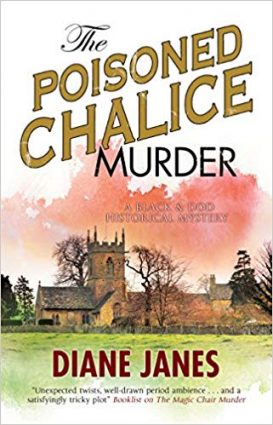 1920’s England and Frances Black and Tom Dod leap at the chance to escape the misery of their personal lives – she wants a much-frowned-upon divorce and he is in a loveless marriage of duty – to investigate a possible murder in the village of Durley Dean. Well, there have been three suspicious deaths amongst people who have spoken out against the new vicar of the parish. Surely one of them was murder…
1920’s England and Frances Black and Tom Dod leap at the chance to escape the misery of their personal lives – she wants a much-frowned-upon divorce and he is in a loveless marriage of duty – to investigate a possible murder in the village of Durley Dean. Well, there have been three suspicious deaths amongst people who have spoken out against the new vicar of the parish. Surely one of them was murder…
The Reverend Pinder has divided the local congregation to the extent that some parishioners have defecting to a neighbouring church, but could defending the Reverend actually be a motive for murder. Or is something more sinister going on?
Timing is everything. After a number of cracking reads in a row – Challenge The Impossible, The Singing Masons and Whistle Up The Devil – it’s inevitable that there will be a book that is simply… fine. And that can make it harder to review a book on its own merits when it doesn’t compare to three cast-iron classics.
This is a classic-style mystery, with clues (neatly summarised by our heroes in the denouement) leading to the murderer. The investigation centres on one murder, the poisoning of a woman by arsenic, with the other two, which have more potential to be accidents, and a strong start, the book does get bogged down with conversations paralleled to our heroes banging on a bit too long about their personal circumstances. It picks up again as the denouement approaches with a well-clued solution – interesting but the motive does seem a little on the predictable side.
I’ll be honest, there didn’t seem to be anything new here, just a straightforward cosy murder mystery that could do with the personal angst being dialled back a step or two, and more of a sense of time – apart from a couple of mentions of war, and the outdated attitude to divorce, it’s felt fairly achronic (thanks to Mrs Puzzle Doctor for that possibly made up word). Fans of MC Beaton will probably enjoy this one.

Beaton? Brutal.
LikeLiked by 1 person
I do love that word… achronic. Made up or not.
LikeLike
My comments about this and its predecessor were much the same. There is no sense of historical period despite the odd reference to contemporary events. They were both pretty average. It did not help that on either side of reading it, I had been reading Simenon, Harriet Rutland and J.V. Turner.
LikeLiked by 1 person
[…] The Poisoned Chalice Murder by Diane Janes – moving on… […]
LikeLike